On this trip we will be visiting my direct maternal ancestors from Elinor Erk Pearson (d2019) to Hannah Delay Hole (d1817) who founded Cincinnati and Miamisburg, Ohio. Direct maternal ancestors follow my mother’s maternal ancestry branch that consist entirely of women i.e., my mother, grandmother, great grandmother, 2nd great grandmother and so on. We will also be stopping to visit other ancestors along our way that are not direct maternal on this visit that are in the same cemeteries. The full round trip is about 110 miles starting and finishing at Richmond, Indiana. I included stories and facts along the way in this book. Direct Maternal Mothers of mine will have their names bolded. This trip will take 4 to 6 hours depending on how long each gravesite is visited.

1) First, we will head to Versailles, Ohio, to visit my 7th-generation direct maternal ancestor, Hannah Delay Hole (d1817), who played a key role in the founding of Cincinnati and Miamisburg. To get there, take Hwy 121 through New Madison and follow other country roads to reach Greenlawn Cemetery, located on the west side of Versailles, Ohio.
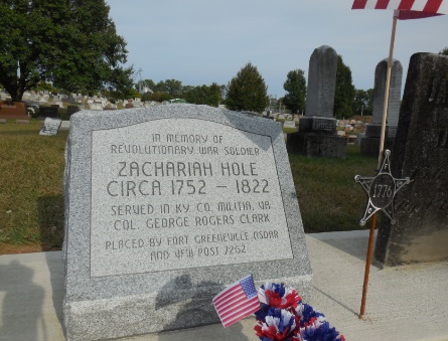
Both Hannah Delay Hole and her husband, Zachariah Hole (d. 1822), are buried here, likely close to their children in the older section on the cemetery's west side. Hannah and Zachariah were the first settlers in Cincinnati and established Miamisburg, Ohio, with the first settlement known as "Hole Station." Their pioneering journey began when they married in 1774 in the Appalachian Mountains, 35 miles west of Winchester, Virginia. The Revolutionary War had just begun, and Zachariah joined the fight against the British. At the time, the Smoky Mountains marked the western boundary of American Colonies, and venturing beyond it meant risking Native American attacks. After the Revolutionary War ended in 1783, pioneers began moving past the colonial frontier. One such family was Hannah, Zachariah, and their five children, along with three of Zachariah’s brothers. They were among the first settlers of Losantiville, now known as Cincinnati. In 1788, they built a station on the Ohio River's banks, where today's Cincinnati Great American Ball Park stands, for protection from Native American attacks. A year later, Fort Washington was constructed nearby, and Cincinnati was chartered as a town in 1802. Before Cincinnati became a town, Hannah and Zachariah took their family up the Great Miami River in 1797 and settled in a new community known as Hole Station, now Miamisburg. As land became available after the Greenville Treaty was signed in 1795, the Hole family continued their journey north, eventually settling near Versailles, Ohio, where they had two more children and spent the rest of their lives. Versailles is situated just south of the Greenville Treaty line. The Greenville Treaty, signed on August 3, 1795, ended the Northwest Indian War, restricted Native American territory to northwestern Ohio, and established annual payments following land concessions. The treaty was signed between the Western Confederacy of Native American tribes and the United States government, represented by General Anthony Wayne and local frontiersmen. This treaty marked the end of the frontier in that part of the Northwest Territory, which would later become the state of Ohio. As you explore Greenlawn Cemetery, use figure 1 for guidance in locating their gravesites within the large cemetery.

2) Next, we travel 17 miles west to the Hillgrove Cemetery, located 3 miles southeast of Union City, Ohio, along road 571. Here, we will visit the grave of Hannah M (Hole) Brandon, my 6th-generation direct maternal ancestor, who passed away in 1853. Hannah was named after her mother and is buried beside her husband, James Brandon (d1876), sharing a gravestone.
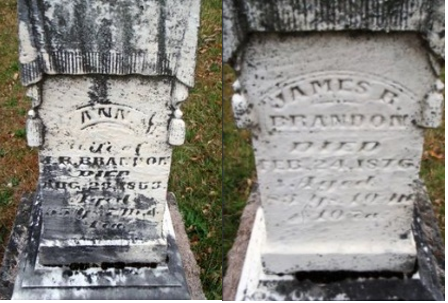
The couple married when Hannah was 26 and had six children, including Mariah, my 5th-generation direct maternal ancestor. Like most people in the 1800s, they were farmers. In 1820, they purchased 160 acres of land from the US government, which was known at the time as the “territory north-west of the Ohio and above the mouth of the Kentucky River.” Hillgrove Cemetery is a small burial ground located at the corner of 571 and Pickett Road. Hannah and James raised their family on their farm, with Mariah Brandon Teeter (d1910) being one of their daughters and my direct maternal ancestor. The gravestone for Hannah is smaller than it appears in the photographs. Refer to figure 2 for the gravesite location.
3) Next, we travel 7 miles east of Union City to the Old Teegarden Cemetery to visit the graves of Mariah Brandon Teeter (d1910) and her husband, John Paul Teeter (d1891). The graves are located on the west side of the church, marked by a large Teeter flagstone that is easy to spot. Mariah was the daughter of Hannah M (Hole) Brandon and my 5th-generation direct maternal ancestor. Mariah and John had nine children together, including their daughter Amanda Teeter. They spent their lives as farmers and likely attended the nearby Teegarden Church. Farming during their time was done with horses, as tractors were not yet available. Their nine children established their own farms in the area, and one of them, Amanda, relocated to the growing town of Richmond, Indiana. Refer to figure 3 for the gravesite location.

4) As you head south from Union City on Route 227 towards Richmond, take a stop at Hoover Cemetery, located 4 miles south. Here, you will find the gravesites of the Wasson family, who are also ancestors of ours, though from a non-direct maternal line. David Wasson II (d1910), his wife Mary (d1892), and his parents, David Wasson I (d1850) and Flora (Graham) Wasson (d1865), are all buried at the Hoover Cemetery. The Wasson family emigrated from Scotland and Northern Ireland around 1795. Flora Wasson has an interesting story to share about dancing with the captain of the ship when she was 14 immigrated to America; you can read about it in the story titled “Dancing with the Captain” in attachment 3.
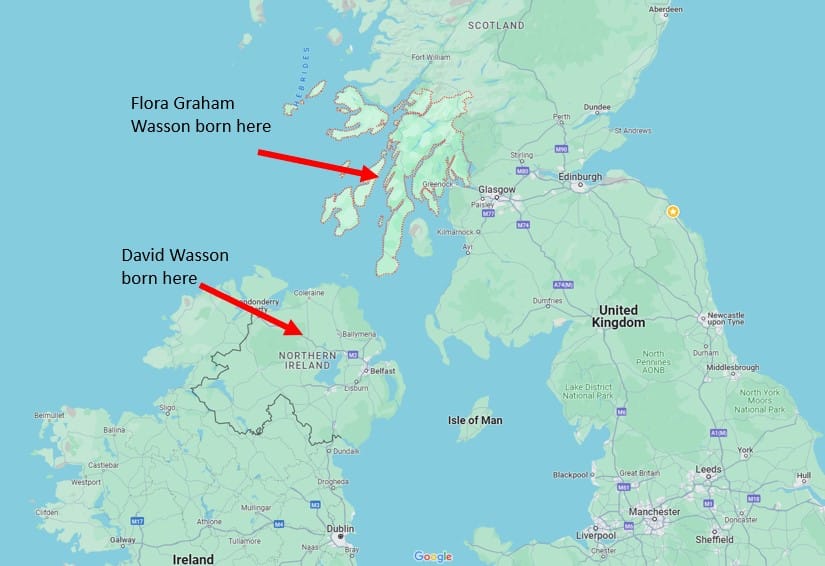
Flora is the source of our Scandinavian DNA as where she was born in Argyll area of Southwest Scotland that had been settled by Norwegians hundreds of years earlier. The Wasson family holds a special place in our family history as the only non-German ancestors in my mother's lineage. Their heritage comes from Scotland, Northern Ireland, and England, making up the 11% Scandinavian and 8% British and Irish DNA. The Erk and Hofheinz families in my mother's family make up 68% of the German DNA found. The Scandinavian, British, and Irish heritage can all be traced back to the Wasson family. Refer to figure 4 for the gravesite locations. In addition, John Paul Teeter’s mother, Hannah Paul (d1872), is also buried here. See if you can locate her gravestone; it's small, white, and low to the ground.
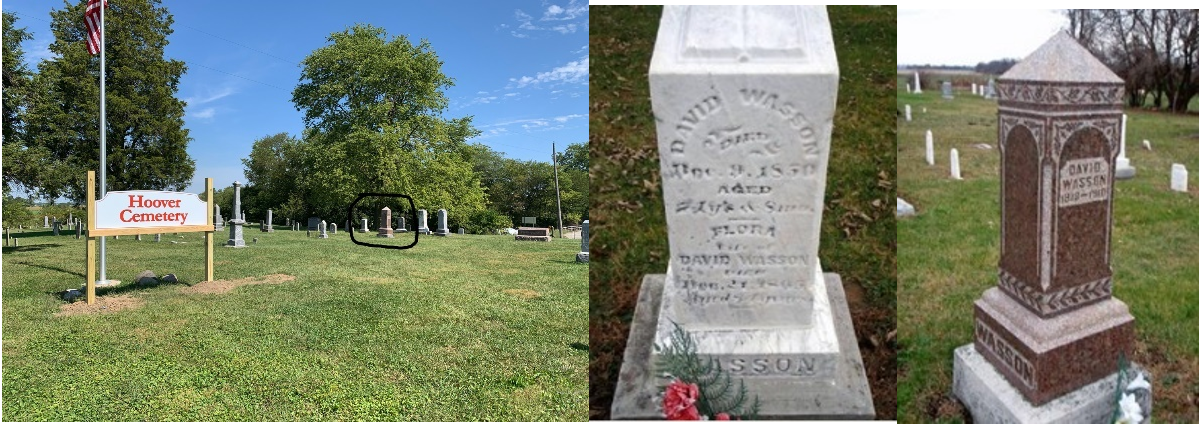
5) Next, we visit the Earlham College Cemetery in Richmond, Indiana, where Amanda Teeter (d1939) and David Wasson III are buried. Amanda is my 4th-generation direct maternal ancestor. You may remember the Wasson graves you visited earlier at Hoover Cemetery—David’s parents and grandparents are buried there. David Wasson III worked in a factory in Richmond before taking on farm labor jobs around Richmond. To learn more about David and Amanda's life, you can read "My Great-Grandparents' Journey" by Tom E. Pearson, which provides insight in Chapter 1. Amanda and David had two daughters, Betsy (Wasson) Krick and Grace (Wasson) Hofheinz, the latter of whom is my 3rd-generation direct maternal ancestor. Tragically, David died 28 years before Amanda from a heart attack while delivering buttercream to a saloon on North E Street in Richmond. Amanda outlived both of her children and husband, living as a maid servant to another family. Betsy passed away in 1915 at age 36 due to an infection from a glass jar cut before antibiotics were discovered. Grace died at 40 years old in 1925 at the Florida State Hospital from a chronic disease also easily cured today with antibiotics. We will not be able to visit today Grace Wasson Hofheinz grave site as she is buried near Tallahassee, Florida. Amanda and David are buried in section 6 of the Earlham graveyard near the lower part of the hill. Refer to figure 5 to easily locate their gravestones.
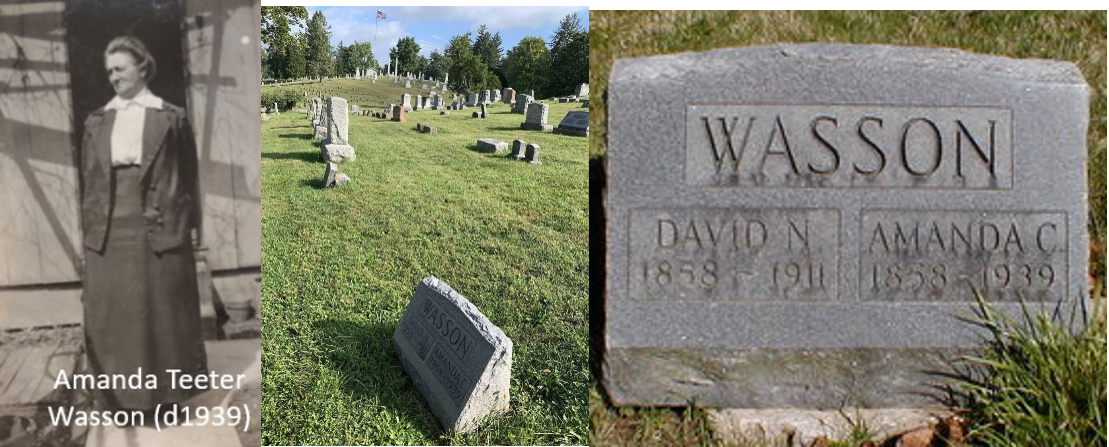
6) 1. Since we cannot visit my next direct maternal ancestor Grace Wasson Hofheinz gravesite today, we will visit her husband and his family grave site at Lutherania cemetery. Ernest Hofheinz (d1948) grave at Lutherania cemetery is south of Richmond, Indiana. His wife Grace Wasson Hofheinz is my 3rd generation direct maternal mother buried near Tallahassee, Florida at the Florida State Hospital in an unmarked grave. Read Grace’s story in “My Great-grand parents Journey” by Tom E. Pearson. Chapter 1 tells their life story. Earnest and Grace’s daughter was Edith Hofheinz who is my 2nd generation direct maternal mother. Ernest is buried next to his father Christian Hofheinz (d1916) and Mother Caroline Hofheinz (d1918) who both emigrated from Germany in 1866 right after the American Civil War. See figure 6 for their gravesite location.

7) Next, visit Edith Hofheinz Erk (d1949) and her husband Walter Erk (d1954) at the Lutherania cemetery. They are buried very close to the Hofheinz family. Edith is my 2nd generation direct maternal mother and my grandmother whom I never met. Edith Hofheinz Erk graduated from Richmond High School and married Walter Erk. They moved onto a farm 1 mile north of Whitewater on 227 and were farmers. She passed away due to chronic inflammation of the heart and kidneys that lead to her kidneys failing at age 42. In her short life, she had 3 daughters and one of them was my mother Elinor Jean Erk. We will visit Elinor’s grave at Goshen cemetery north of Richmond on 227, but first we will visit Elinor’s mother grave Edith, and her father’s ancestors who are buried in the buried at the Lutherania cemetery. The Hofheinz and Erks were German immigrants that came directly to Richmond, Indiana right after the American Civil war. Both families attend the Lutheran Church in Richmond, Indiana. Minnie Luker Erk (d1954) and William Erk (d1950) were Walter Erk’s parents, and they are buried in section 6 of the Lutherania cemetery. Edith Hofheinz Erk, my 2nd generation direct maternal mother is buried with her husband Walter Erk at this grave site. Walter’s great grandparents who emigrated from Germany in 1866, Hermon Erk (d1896) and Dorothy Erk (d1918) are buried in the front part of the cemetery next to the road. See figure 6 to see the location of gravestones in the Lutherania cemetery. Erk oldest daughter was Elinor Hofheinz Erk who is my 1st generation direct maternal mother.
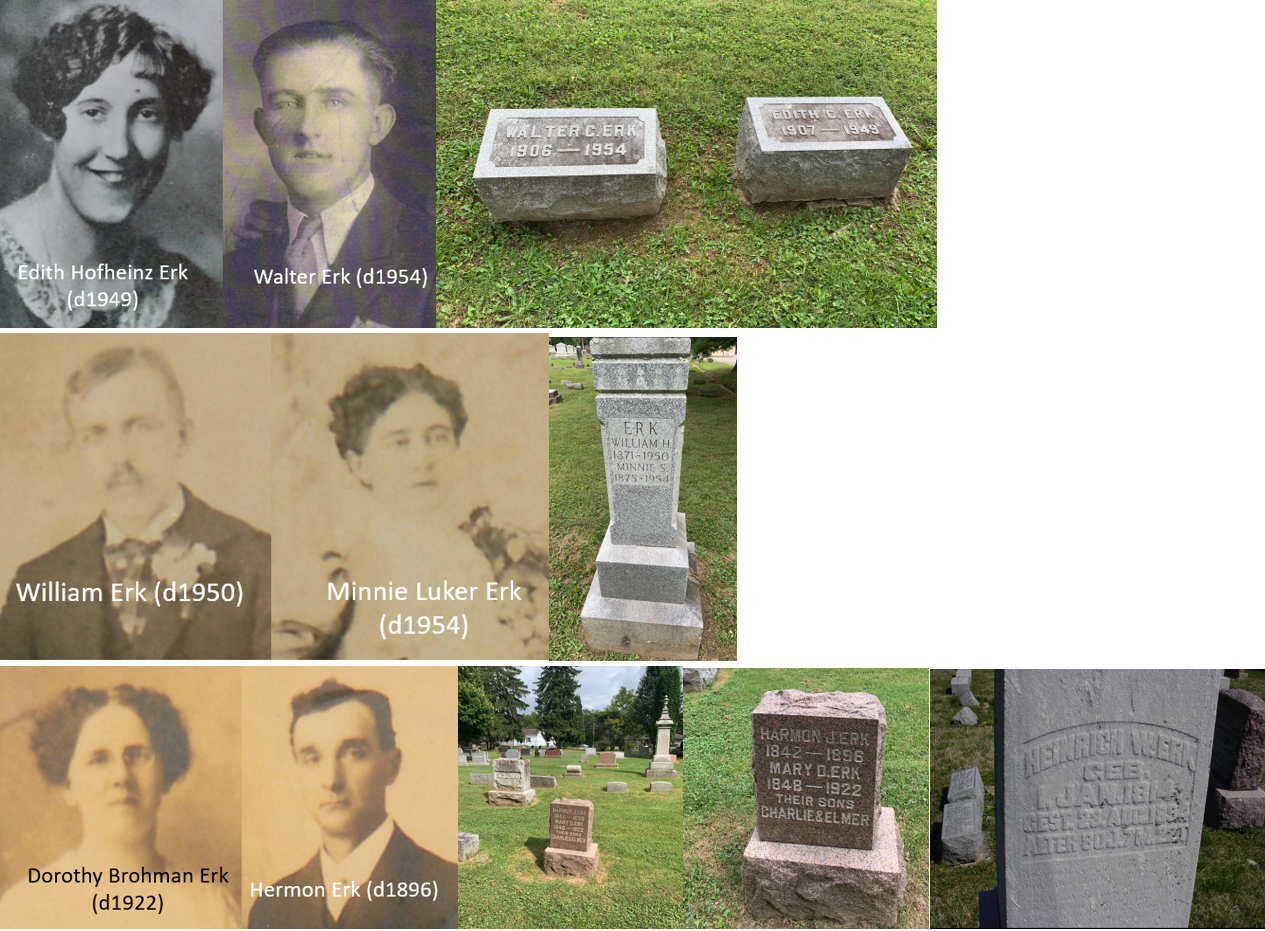
8) At the same cemetery we will now visit Eliza (Weaviner) Luker’s grave in Lutherania cemetery in Section 3 of the Lutherania cemetery. She is my 2nd great-grandmother however not a direct maternal mother. Her grave is next to her mother and fathers grave John and Susanna Weaviner (my 3rd great-grandmother/father) as she died an early death just after her first child Minnie (d1954) who is my great grandmother. Minni’s father Charles Luker emigrated from Germany however her mother’s family, Susanna (Ruby) Weaviner (d1894), had been in America 100 years prior before emigrating from Germany. Eliza Weaviner and Charles Luker daughter, Mini, is buried in the same location next to her husband William Erk. See figure 6 for their gravestone location.
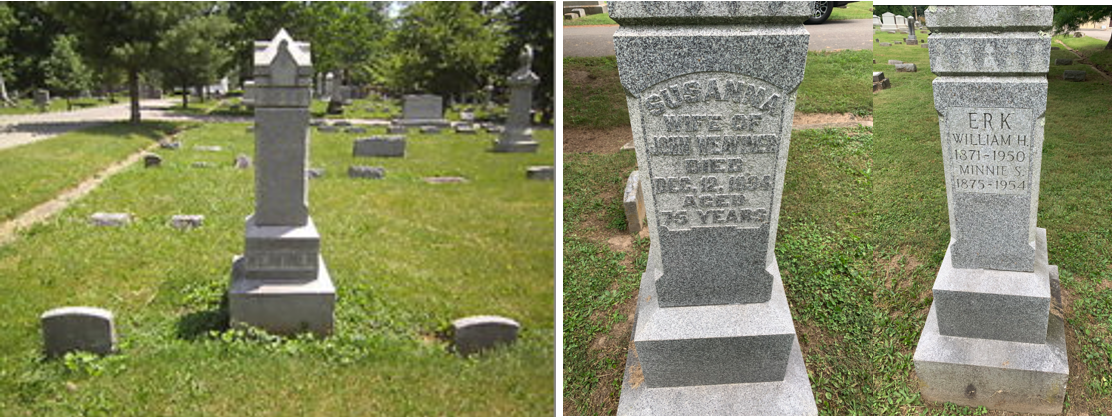
9) If time allows, we can visit Eliza Weaviner Luker’s husband’s grave at Crown Hill cemetery in Centerville. His name is Charles Luker and is buried with his 2nd wife. Charles outlived three wives and lived until 96 years old. He emigrated from Germany when he was 2 years old. He is my 2nd great-grandfather. He is buried in the old cemetery area in section 3 near the front with his 2nd wife Lizzie. See figure 7 for gravestone location.
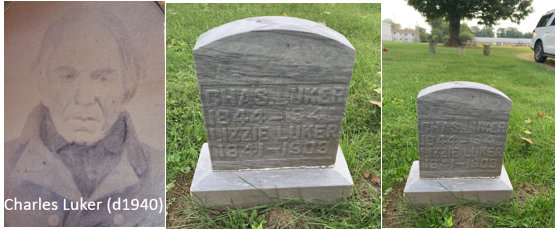
10) Finally, we head to Goshen Cemetery to visit the burial site of Elinor Erk Pearson (d2019) and her husband, John Pearson (d2012). Their farm was located one mile north of Whitewater on Hwy 227, and you will pass it on your way to the cemetery. Elinor and John are my parents. To learn more about them, please read "My Great-Grandparents' Journey" by Tom E. Pearson. You can find their gravestone location in Goshen Cemetery in figure 8 below. we travel to Goshen Cemetery where Elinor Erk Pearson (d2019) and her husband John Pearson (d2012) are buried. One mile north of Whitewater was their farm on Hwy 227. You will pass it as you drive to Goshen Cemetery. They are my mother and father. To learn more about them please read “My Great-grand parents Journey” by Tom E. Pearson. Their gravestone location at Goshen Cemetery is in figure 8 below.

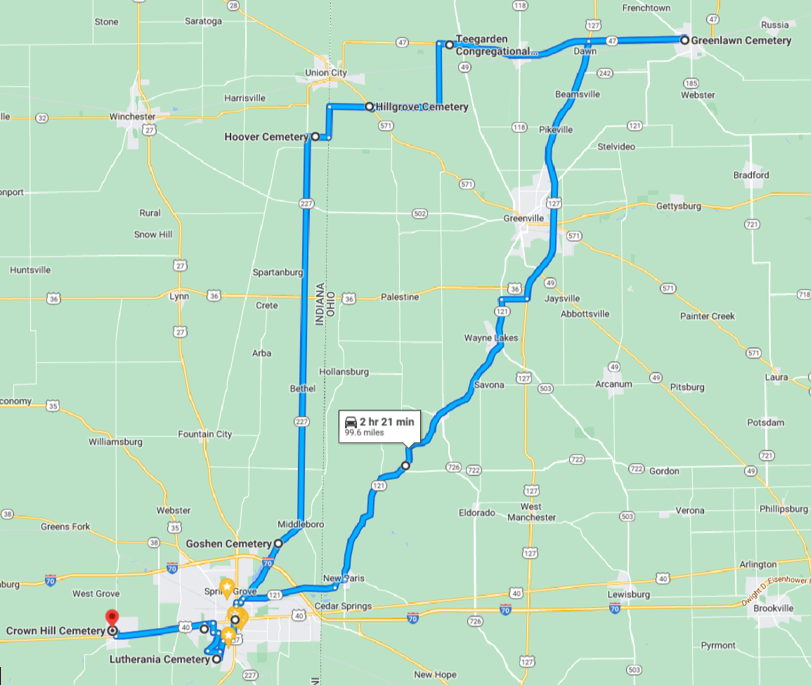
Suggested map of trip to visit ancestors’ grave sites
Attachment 1:
Hannah Delay Hole and Zachariah Hole were Pioneers
Hannah and Zachariah and their families were among the first settlers in Losantiville Station that is now called Cincinnati. Hannah Delay Hole, her husband Zachariah Hole and his brothers erected an outpost civilization in 1789 that is located today just behind right field of the Cincinnati baseball stadium.
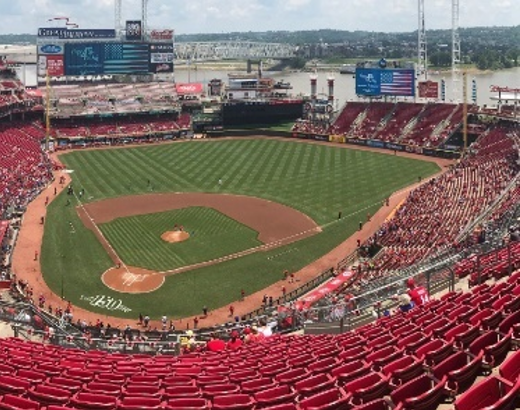
When the Revolutionary War (1775-1783) was over, the undeveloped Ohio country was American territory. Like many veterans of the war, Virginian Zachariah Hole brought his family over the mountains into the wilderness north of Kentucky. By January of 1789, the founders of Cincinnati had completed their surveys and plot maps. Among the first few families to buy their land was that of Zachariah and Hannah Hole and their first five children. The families of Hannah Hole family, Zachariah's brothers Daniel, John, and William, the Hole clan made up a large part of Cincinnati's civilian population in 1789. They pooled their resources, labor, and land to construct Losantiville Station among the hardwood forests along the banks of the Ohio where now sits the Cincinnati Reds baseball stadium. A station was a wooden stockade built to house several families until it was safe to go out and establish individual homesteads.
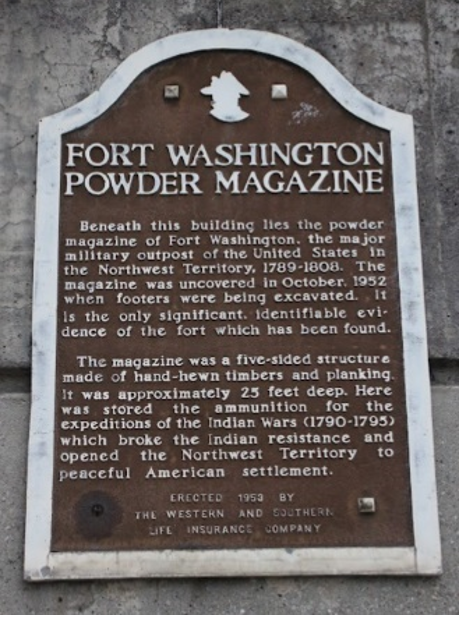
At the same time, on a hill a few hundred yards away, the new US government was building Fort Washington, a major regional army base on the Ohio. While the British had withdrawn after the Revolution, they were still encouraging Indian raids on settlers and outposts throughout the Ohio country. Braves under Chief Blue Jacket of the Shawnee and Chief Little Turtle of the Miami tribe were concerned about the future of their hunting grounds. In June of 1791, John Van Cleve, a blacksmith at Fort Washington, "was stabbed in five places, killed, and scalped" less than a mile from Losantiville Station. Until the victory at the Battle of Fallen Timbers in 1794 and the Treaty of Greenville in 1795, it was unsafe for individual families to settle far from the forts.
Hole’s station - First homestead in Miamisburg.
By 1797, Zachariah and Hannah had left the protection of Fort Washington to go up the Miami River and establish Hole's Station on the future site of Miamisburg, Ohio. They were the first settlers of Miamisburg 220 years ago when they built Hole station. Stations were stockades that they lived in fearing harm from the Native Americans. However, the Native Americans proved to be friendly, and more settlers joined them at Hole station to what became Miamisburg.
Attachment 2:
Hole’s Station
In 1797, the area around what would become Miamisburg, Ohio, was a wilderness. In that year, Zachariah and Hannah Delay Hole and their family trekked north 40 miles from the frontier village of Cincinnati and the protection of Fort Washington to build a collection of log cabins within a wooden stockade that became known as Hole's Station. From the website cityofmiamisburg.com/about/ "About 1797, Zachariah Hole came with his family ... he built a stockade on the East bank of the Miami River opposite the mouth of Bear Creek. He found the Native Americans friendly.
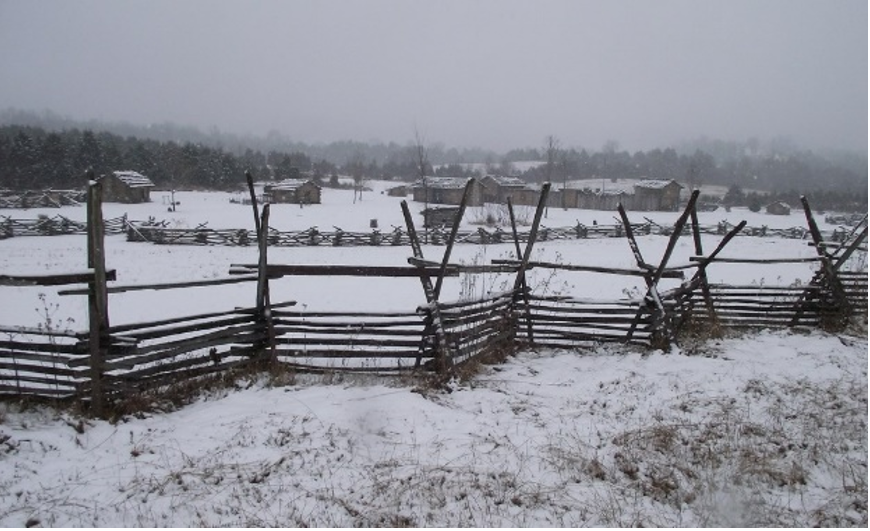
To the stockade came squatters, surveying parties, and settlers mostly from Pennsylvania who had taken out grants and lived there until their own cabins were completed; hence the small community came to be known as 'Hole's Station. Hannah's father James Delay died a year after she was born on the northern Virginia frontier in 1752. A few years later, what is now Hampshire County, West Virginia, was almost depopulated due to heavy raids during the French and Indian War. By 1774, a grown-up Hannah married Zachariah Hole in nearby Loudoun County, WV where the family settled. Zachariah joined patriot Virginia forces during the Revolutionary War. By 1789, the family was among the first to settle Cincinnati in "The Territory Northwest of the River Ohio" where, along with Zachariah's brothers, they helped to establish Losantiville Station on the riverfront. From there, it was up the Miami River to create Hole's Station, a welcome sight for travelers and settlers for many years. A station was a defensible privately-owned stockade. It contained one or more log cabins and barns, with a wooden fence around it embracing enough ground to shelter several families.
Below is from correspondence of John Cleves Symmes, founder of the Miami Purchase with Hole:
This will testify to all concerned that upon the express condition of Zachariah Hole and his companions or associates actually settling and finally establishing a Station of cabins or houses, clearing land, cultivating the earth and maintaining a Station as aforesaid in the sixth entire range of townships in the Miami purchase on any land not already located and entered on the map or record, and that within the following periods of time, ten Cabins shall be raised and covered with Clapboards or puncheon by next Christmas day, and thirty acres of land shall be well cleared.
By the first of June 1796, the Station shall be settled and protected by at least ten men who shall be more than sixteen years of age, and each man well provided with a good gun, powder and lead for defense in case of danger. Then in such case and not otherwise, the said John Cleves Symmes will bestow free gratis on the men settling the Station, whether ten men or more, one hundred acres of land to be divided equally between them, wherever they may build such Station in said Sixth Range not on lands already located.
Coming to Ohio from Virginia, Zachariah Hole with his wife and three sons located at Hole’s Station, on the cast bank of the Miami opposite the mouth of Bear Creek. In 1799 a blockhouse was built here which became the nucleus of Miamisburg. Edgar, Pioneer life in Dayton, pp. 57-58.
Zachariah and Hanna lived in todays Miamisburg until at least 1806 and most likely much later. Their children saw opportunities north near Versailles, Ohio where they bought land from the government for their farms. In their older ages they moved to Versailles with their sons William and James and is where they are buried now. Hannah died in 1817 at the age of 65 and her husband Zachariah died in 1822 at the age of 70 and will forever be known as the founders of Miamisburg, Ohio.
Attachment 3:
Dancing with the Captain
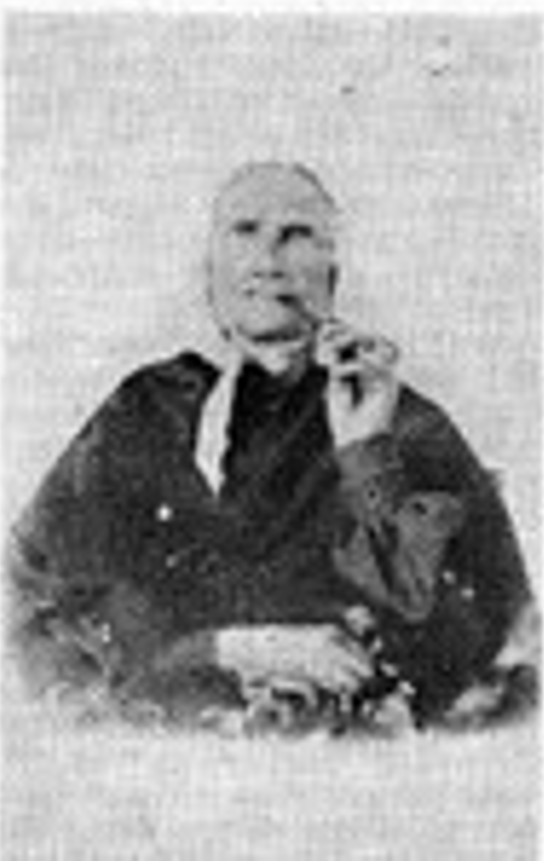
David and Flora Graham Wasson settled in Darke County, Ohio where they lived the rest of their lives. The original 40 acres which they bought from the government has always been in the family and is now part of the farm owned by his great-great grandson. David and Flora were Presbyterian and are buried in Hoover Cemetery. Flora came to America when she was 14 years of age from Argyll, Scotland. Her husband David Wasson I emigrated from Tyrone, Northern Ireland in his mid-twenties. A grandson remembered her answer to the question of how Flora came to America was “I come on a ship and danced with the captain.” She had a brother, Tommy Graham who was a sailor. Picture above is Flora Graham Wasson with a tobacco pipe in her hand.

Figure 1: Zechariah and Hanna Hole gravesite location at Greenlawn Cemetery, Versailles, Ohio
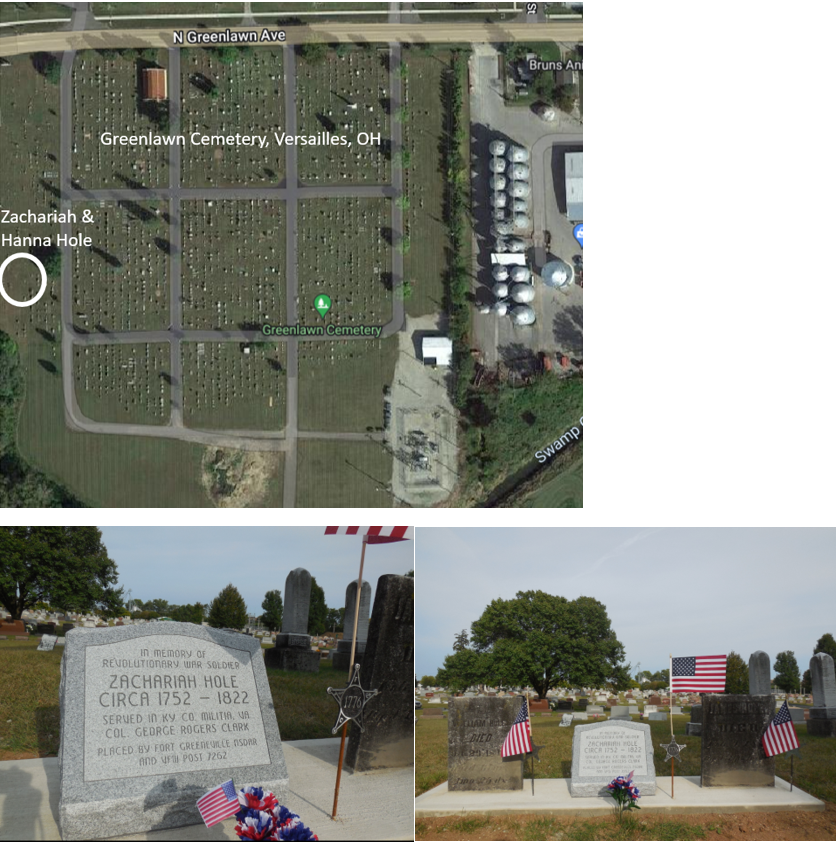
Figure 2: Grave site location of Hannah (Anna) Hole Brandon (d1853) at the Hillgrove Cemetery southwest of Union city, OH. Her husband James Brandon (d1876) is buried next to her.
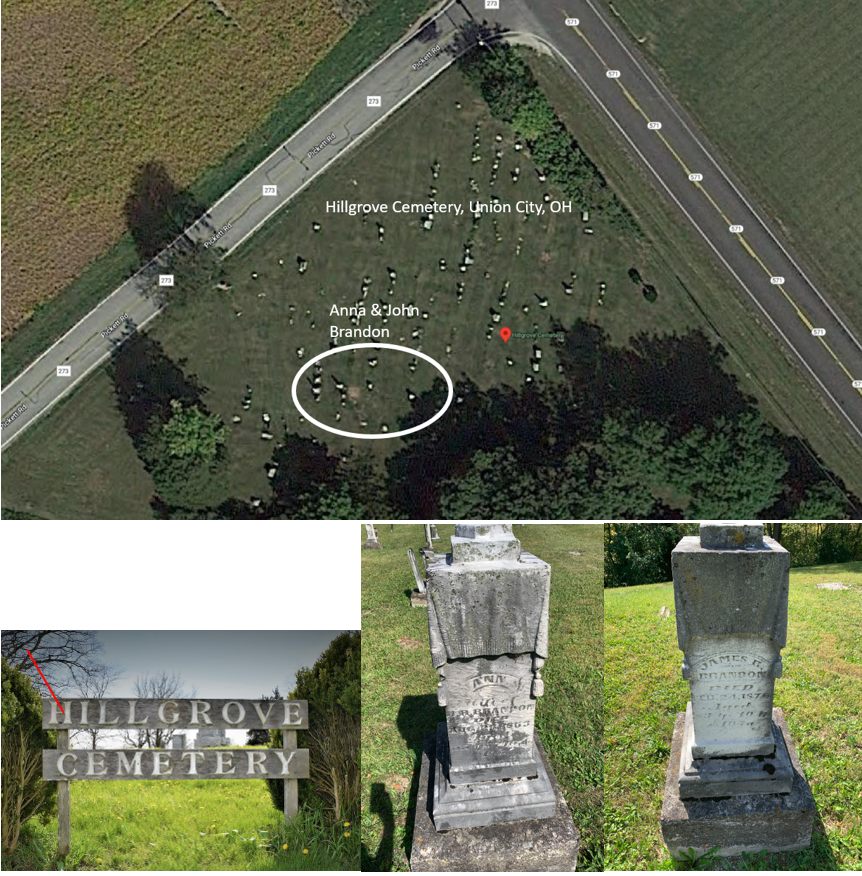
Figure 3: Gravestones of Mariah (Brandon) Teeter (d1910) and John Teeter (1891) at the Teegarden Cemetery east on Union City, IN.

Figure 4: Flora & David Wasson gravesite at Hoover Cemetery, Union City, Indiana
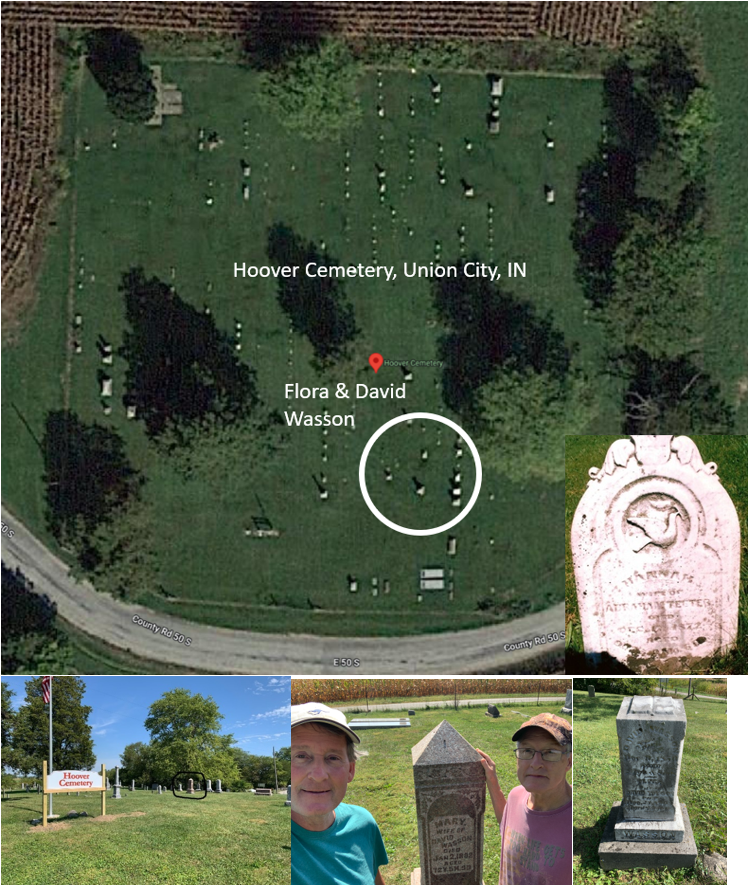
Figure 5: David & Amanda Wasson gravesite at Earlham College Cemetery, Richmond, Indiana
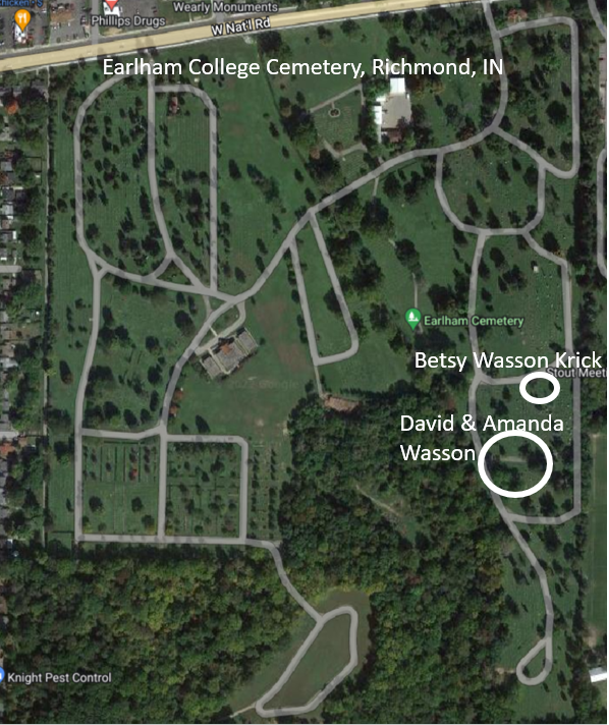
Figure 6: Erk and Hofheinz gravestones at Lutherania Cemetery in Richmond, IN
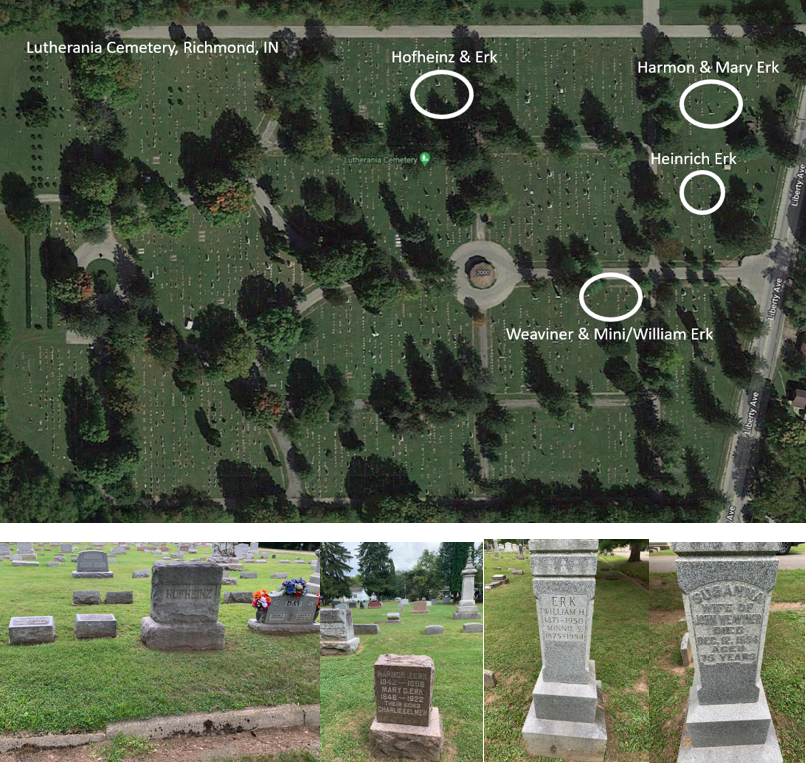
Section 1, Lot 019- Heinrich Erk – patriarch Erk who immigrated in 1867 with his family at age 53.
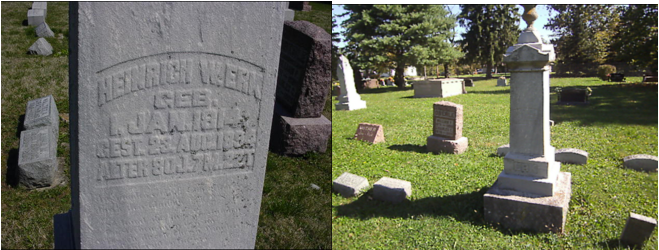
Figure 7: Charles Luker gravestone at Crown Cemetery in Centerville, IN
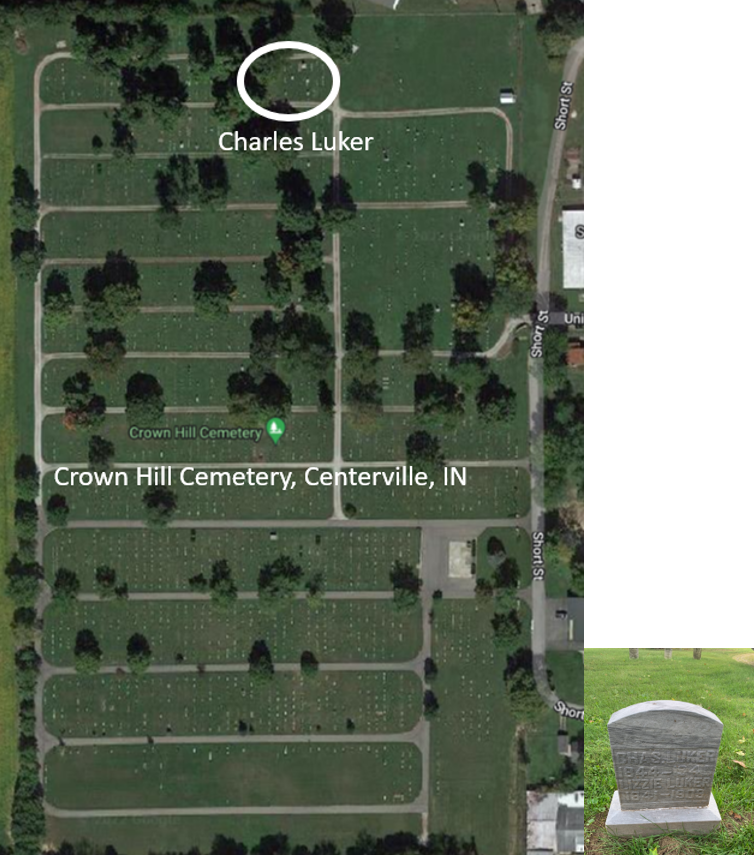
Figure 8: Elinor & John Pearson’s gravestone at Goshen Cemetery near Middleboro, Indiana
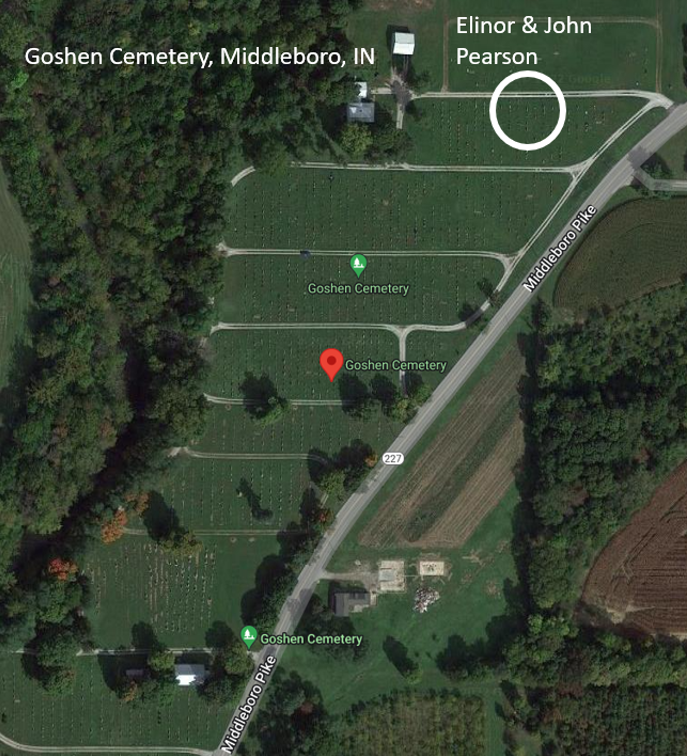
Figure 9: This tree has my last 4+ generation of my ancestors and in red the graves sites they are buried.
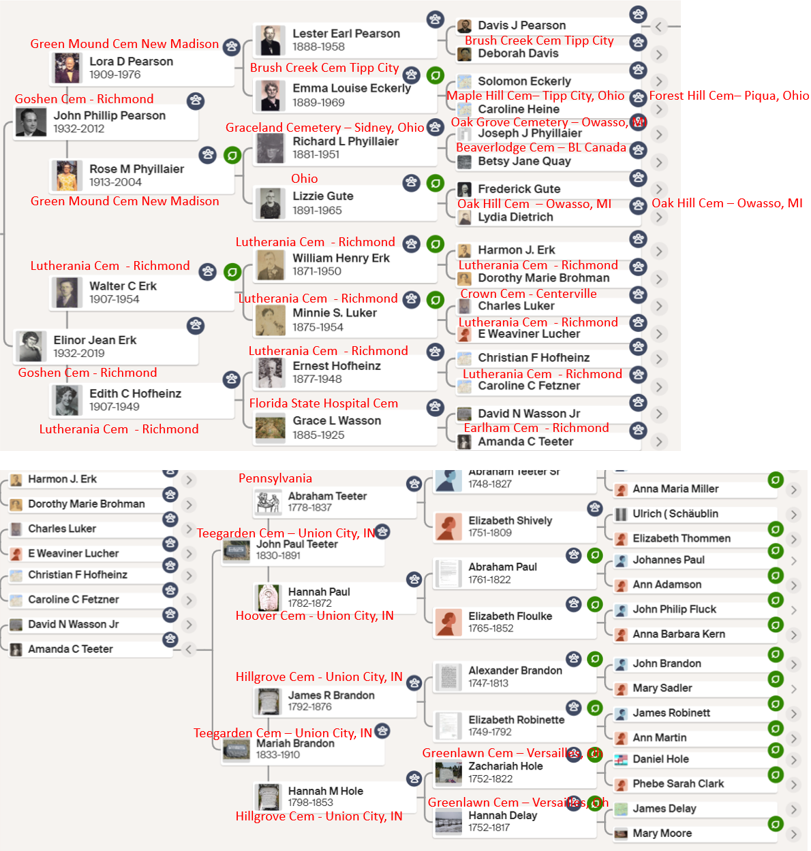

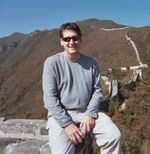
Member discussion: